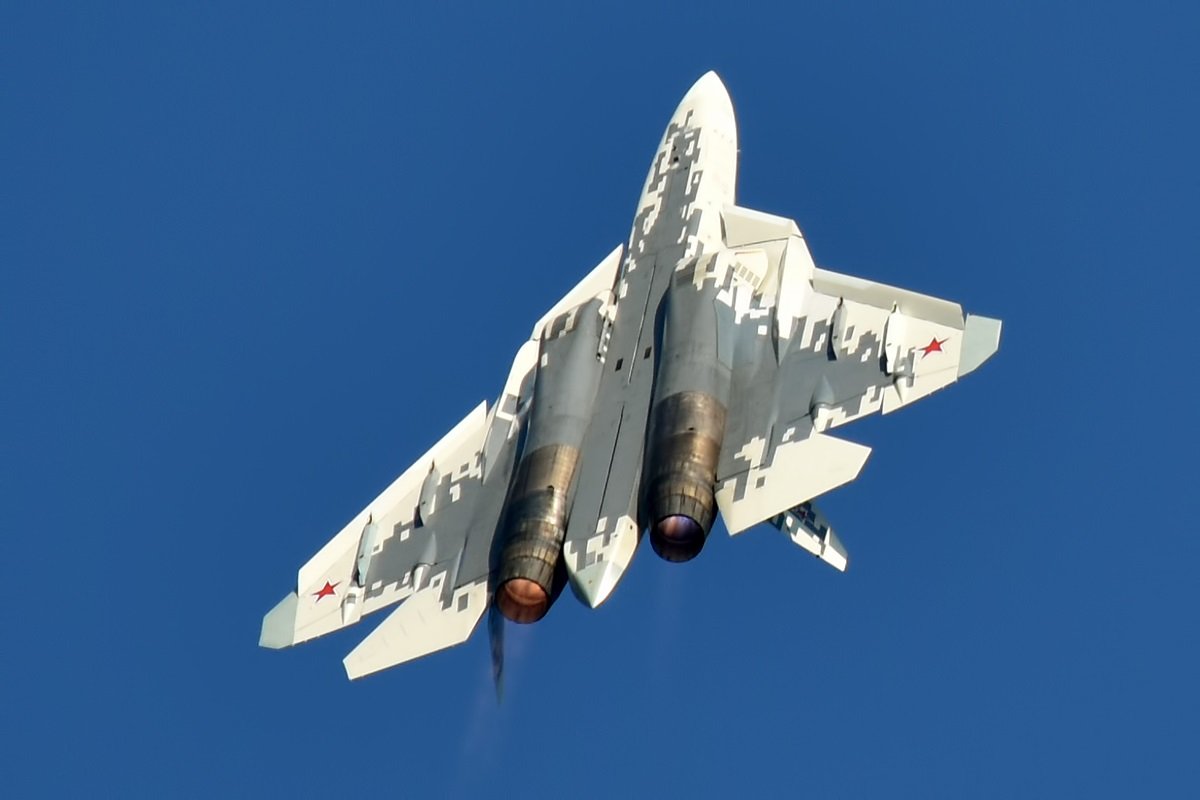A video purportedly depicting Russia’s Su-57 fighter jet flying along the country’s shared border with Ukraine circulated this week. In a tweet published by Pacific Geopolitics, the multirole airframe appears to perform various maneuvers and looks impressive, albeit for a distance. However, the exact location of the jet cannot be verified from the video alone – it clearly could have been flying from anywhere.
But Moscow would love for us to believe otherwise. Russian military officials have long claimed that its only operable fifth-generation stealth fighter has performed well since the onset of the Ukraine invasion. Even Russia’s Defense Minister Sergei Shoigu has boasted that the Su-57 “Felon” airframe has been used “brilliantly” in combat. Yet, evidence corroborating these statements appears to be non-existent. The Kremlin has utilized misinformation and flagrant propaganda to justify and enhance its war efforts in Ukraine for months, making these narratives about the S-57 more implausible.
The History of the “Felon”
The twin-engine fifth-generation stealth fighter was developed by the Russian manufacturer Sukhoi in the late 1990’s, taking its first flight in 2010. As the first Russian airframe designed with stealth technology, the “Felon” was created to counter other fifth-generation fighters- most notably the American-made F-22 Raptor and F-35 Lightning II. While Moscow has had big hopes for the Felon, its production and development timelines struggled due to multiple factors. Structural and technical issues became apparent during the Su-57’s trial flights, including the crash of the first production airframe prior to its delivery. One of the primary issues with the early models of the Felon was its tendency to crack. Ultimately, manufacturers integrated stronger materials to help alleviate the cracking. Despite this, other problems contributed to the jet’s production. Currently, only a handful out of the projected 60 airframes have entered service.
Su-57: Capabilities and weapons
While the exact specs and capabilities of the Felon remain unclear due to the lack of verifiable intelligence and the airframe’s minimal operational flights, the fighter certainly elevates Moscow’s aerial prowess. Although industry experts assert that the Su-57 is less stealthy than its near-peer fifth-generation fighters, the Felon is the stealthiest airframe in Russia’s arsenal. The fighter integrates 3D thrust vectoring controls, unlike China’s J-20 “Mighty Dragon” stealth airframe, which enhances its maneuverability at high speeds and altitudes. Some military experts believe that the Felon’s thrust vectoring capabilities are even superior to the American-made F-22 Raptor– which is often assumed to be the world’s most capable air-to-air fighter. According to Air Force Technology, “Advanced avionics are integrated into the aircraft with a high level of controlled automation and intelligent crew support. The improved avionics will reduce the pilot workload, allowing him to focus on tactics and strategies. Furthermore, the fighter will enable the pilot to exchange data and communication in real-time with control systems on the ground and with air groups. The aircraft has an active electronically scanned array (AESA) radar mounted on the nose and two side-facing AESA radars mounted on the aircraft’s cheeks for improved angular coverage.”
Weapons-wise, the Felon features two side bays storing short-range air-to-air missiles and two internal weapons bays mounted between the engines. The airframe’s ability to carry advanced weapons make the Su-57 a potentially formidable threat. The capability to carry weapons internally will minimize drag and enable the airframe to maintain a low radar profile which helps keep it undetectable. The Felon can carry four beyond-visual-range (BVR) missiles and two short-range missiles. The airframe can also be fitted with the Kh-38 tactical ground missile for ground strike capabilities.
What about the engine?
Perhaps the most prevalent issue facing the successful roll-out of the Su-57 is the development of its second-generation engine. Initially, the Felon was designed to be powered by the Izdeliye 30 engine; the current models sport an older engine. A Rand Corporation report noted that a former Sukhoi aircraft engineer said that more than seventy “operational” models of the Felon intended to be used by the Russian Federation Air Force will not feature the Izdeliye engine. Additionally, “Aside from the advanced engine, the Su-57 is touted as having an all azimuth, a.k.a. 360-degree sensing capacity similar to the F-35. After all, what makes a fifth-generation fighter bomber is not just its low observable (LO) features but also the advanced all azimuth sensor suite. At the present time, only the F-35 has both of these features and is in mass production.”
Despite the prolonged delays of the Su-57’s development and production, Moscow still touts that its stealth fifth-generation fighter could outperform its American-made counterparts. The Kremlin hopes to procure 78 prototypes by 2028, however, this figure seems unlikely considering the airframe’s history. Regardless, Moscow is expected to continue to boast about the Felon’s role in its Ukraine invasion– even if evidence that these airframes have actually led successful operations in the war do not come to fruition.
Maya Carlin is a Defense Editor with 19FortyFive. She is also an analyst with the Center for Security Policy and a former Anna Sobol Levy Fellow at IDC Herzliya in Israel. She has by-lines in many publications, including The National Interest, Jerusalem Post, and Times of Israel.

